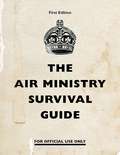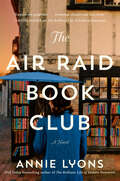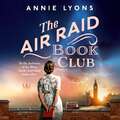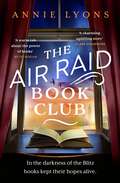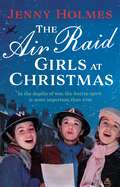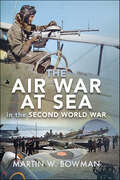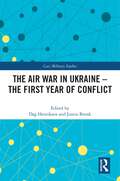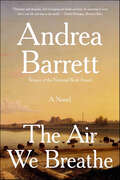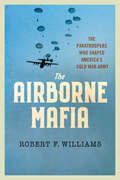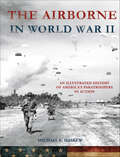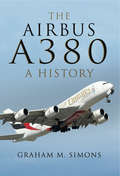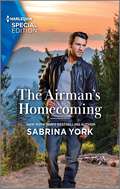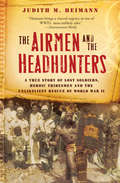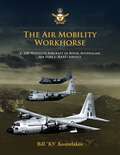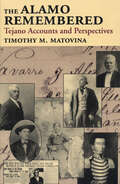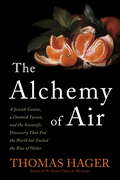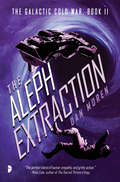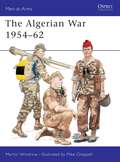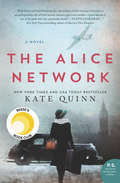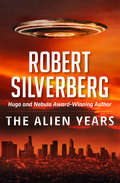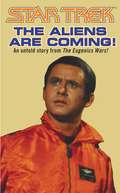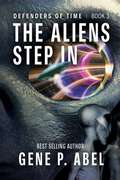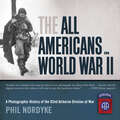- Table View
- List View
The Air Ministry Survival Guide (Air Ministry Survival Guide)
by AnonTHE ULTIMATE SURVIVAL GUIDE for anyone who thinks they'd survive the world's most hostile environments - or at least imagine they could do.-----------------------------First issued to British airmen in the 1950s the beautifully illustrated Air Ministry Survival Guide provides invaluable practical tips and instruction on how to keep calm and carry on in any hostile environment.Whether you're lost in the desert, arctic, jungle, or adrift on the open ocean, you'll be better off armed with sensible advice on how to:- Build a structurally sound igloo- Pull faces to prevent frostbite (and when to expect bits to fall off should you fail)- Fashion a mask to prevent snowblindness- Make a hat out of seat cushions- Behave in the event of meeting hostile locals- Stay safe from poisonous reptiles and insects- Use a 'fire thong'- Punch man-eating sharks (which are cowards)
The Air Raid Book Club: A Novel
by Annie Lyons"A wonderful, heartwarming read." — Ruth Hogan, author of Keeper of Lost ThingsFrom the USA Today bestselling author of The Brilliant Life of Eudora Honeysett comes a heartwarming story of found family, love, and making connections through books set against the bombing of London during WWII.London, 1938: The bookstore just doesn’t feel the same to Gertie Bingham ever since the death of her beloved husband Harry. Bingham Books was a dream they shared together, and without Harry, Gertie wonders if it’s time to take her faithful old lab, Hemingway, and retire to the seaside. But fate has other plans for Gertie.In Germany, Hitler is on the rise, and Jewish families are making the heart-wrenching decision to send their children away from the growing turmoil. After a nudge from her dear friend Charles, Gertie decides to take in one of these refugees, a headstrong teenage girl named Hedy. Willful and fearless, Hedy reminds Gertie of herself at the same age, and shows her that she can’t give up just yet. With the terrible threat of war on the horizon, the world needs people like Gertie Bingham and her bookshop.When the Blitz begins and bombs whistle overhead, Gertie and Hedy come up with the idea to start an air raid book club. Together with neighbors and bookstore customers, they hold lively discussions of everything from Winnie the Pooh to Wuthering Heights. After all, a good book can do wonders to bolster people’s spirits, even in the most trying times.But even the best book can only provide a temporary escape, and as the tragic reality of the war hits home, the book club faces unimaginable losses. They will need all the strength of their stories and the bonds they’ve formed to see them through to brighter days.
The Air Raid Book Club: This uplifting World War 2 historical novel is the perfect gift for book lovers
by Annie LyonsAn emotional and uplifting novel set in WW2 London about the remarkable power of books to bring hope and light in dark times, inspired by true events, from the USA Today bestselling author.As the bombs began to fall, the book club kept their hopes alive...London, 1938. Bookseller Gertie Bingham is facing difficult times, having just lost her beloved husband, Harry, and with a lingering sadness at never having been able to have a child of her own. Struggling to face running the bookshop she and Harry opened together, Gertie is preparing to sell up and move away when she is asked if she would be willing to take in a young Jewish refugee from Germany. Gertie is unsure and when sullen teenager Hedy Fischer arrives, Gertie fears she has nothing left to give the troubled girl. But when the German bombers come and the lights go out over London, Gertie and Hedy realise that joining forces will make them stronger, and that books have the power to bring young and old together and unite a community in need in its darkest hour...*Annie Lyons was shortlisted for the RNA Contemporary Romantic Novel of the Year Award* Readers adore The Air Raid Book Club:'A warm and tender tale about the power and healing of friendship and community and the magic of books' - Ruth Hogan'A charming, uplifting story of resourceful women and the healing power of books' - Clare Chambers, bestselling author of Small Pleasures'A tender, touching and utterly heart-warming tale' - Sarah Steele, author of The Lost Song of Paris'Annie Lyons has cleverly woven the horror and heartbreak of war with the resilience of human nature, the strength of love, and the importance of friends . . . perfect for fans of Lissa Evans and AJ Pearce' - Kerry Barrett'Warm and nostalgic . . . This story of love, bravery and found family is heart-wrenching and utterly charming. I sobbed my way through the final chapters' - Fiona Lucas(P) 2023 Headline Publishing Group Ltd
The Air Raid Book Club: This uplifting World War 2 historical novel is the perfect gift for book lovers
by Annie Lyons'Touching and heartwarming . . . get those tissues ready' - Jill Mansell'A warm and tender tale about the power of books' - Ruth HoganAs the bombs began to fall, the book club kept their hopes alive...London, 1938. Bookseller Gertie Bingham is facing difficult times, having just lost her beloved husband, Harry, and with a lingering sadness at never having been able to have a child of her own. Struggling to face running the bookshop she and Harry opened together, Gertie is preparing to sell up and move away when she is asked if she would be willing to take in a young Jewish refugee from Germany. Gertie is unsure and when sullen teenager Hedy Fischer arrives, Gertie fears she has nothing left to give the troubled girl. But when the German bombers come and the lights go out over London, Gertie and Hedy realise that joining forces will make them stronger, and that books have the power to bring young and old together and unite a community in need in its darkest hour...Readers adore The Air Raid Book Club:'I loved this . . . a sweet and nourishing ode to books that historical fiction fans will love' - Kate Thompson 'A charming, uplifting story of resourceful women and the healing power of books' - Clare Chambers'Tender, touching and utterly heart-warming' - Sarah Steele'A wonderful story of strong female friendship and found family . . . I absolutely adored it' - ⭐ ⭐ ⭐ ⭐ ⭐ Real reader review'Beautiful and moving in a way that we need right now' - ⭐ ⭐ ⭐ ⭐ ⭐ Real reader review'A beautiful depiction of a community striving to survive together' - ⭐ ⭐ ⭐ ⭐ ⭐ Real reader review'A gentle, heartwarming read' - ⭐ ⭐ ⭐ ⭐ ⭐ Real reader review
The Air Raid Girls at Christmas: A wonderfully festive and heart-warming new WWII saga (The Air Raid Girls Book 2) (The Air Raid Girls #2)
by Jenny HolmesThe second book in the Air Raid Girls series - a wonderful new Christmas story of friendship, love and duty in wartime, perfect for fans of Elaine Everest and Rosie Hendry.Don't miss part 3 in the series - The Air Raid Girls: Wartime Brides is available now!---------------------------------------------November, 1941.Christmas is coming... and despite the blackout, shortages and a constant threat of air raids, the inhabitants of Kelthorpe on the Yorkshire coast are determined that war won't stop them celebrating.The run-up to Christmas sees sisters Connie and Lizzie, and their good friend Pamela, busier than ever. Between their jobs, carol-singing rehearsals with the church choir and night shifts doing their bit as Air Raid Wardens and ambulance drivers, it's all go.But when Connie and Lizzie's dear dad falls ill, their sweethearts Tom and Bill are called up by the Royal Navy for dangerous mine-sweeping duties, and Pamela's sweetheart Fred is targeted by vicious locals, the girls have to believe in miracles to keep soldiering on.Can their dearest wishes come true this Christmas?'A festive tonic!' Peterborough Telegraph'An ideal stocking filler for those who enjoy a well-written novel depicting wartime life' Holderness Gazette'An evocative and nostalgic book about love, family, friendship and fortitude' Culturefly, 6 Uplifting Books to Read over the Festive Season---------------------------------------------Readers LOVE the Air Raid Girls series:'There wasn't anything I didn't like about this book' 5 star review'In all the women at war series of book I have read so far, I think this is the best' 5 star review'I couldn't put this book down' 5 star review'Loved the whole story. Hated it coming to an end' 5 star review'Just the kind of book I like' 5 star review
The Air War In Europe
by Ronald H. Bailey Time-Life Books StaffAt the weary close of World War I, air power was just a gleam in the eyes of a few farsighted men, notably British Chief of the Air Staff Hugh Trenchard and the assistant chief of the U.S. Army's Air Service, William "Billy" Mitchell. But as planes were improved by new technology, the idea of air power gained strength and followers.
The Air War at Sea in the Second World War
by Martin W. BowmanMartin Bowman’s considerable experience as a military historian has spanned over forty years, during which time he has spent hundreds of hours interviewing and corresponding with numerous men and women and their relatives, in Britain, America and beyond, resulting in a wealth of material on the war at sea from World War One to the Falklands and the wars on terror. All these narratives have been woven into a highly readable and emotional outpouring of life and death in action in all his titles, as here, in World War Two, where the men of the Fleet Air Arm and the US Navy fighter (operating bomber and torpedo carrying aircraft) describe the compelling, gripping and thought-provoking narrative of the air war in the freezing Atlantic wastes to the waters of the mighty Pacific.
The Air War in Ukraine: The First Year of Conflict (Cass Military Studies)
by Dag Henriksen Justin BronkThis book provides a comprehensive account of the use of airpower in the first year of the Ukraine conflict.Airpower has been central to political, military, and public debates from the outset of the Russo‑Ukrainian war. After having started with whether the US and NATO should attempt to establish a No‑Fly Zone over Ukraine to protect the civilian population, the international discussion soon focused on the underperformance of Russian airpower. The fact that the initial contest for air superiority over Ukraine ended in an uneasy state of mutual denial came as a surprise to Western analysts, who suspected Kyiv would fall within a relatively short period of time. The surprise and relief that it did not only fueled urgent and ongoing discussions on how NATO nations could support the Ukrainian war effort. Regardless of nationality, age, level of education, or ethnicity, the near‑daily footage of Russian missiles, bombs and drones hitting residential areas and bombarding infrastructure to deprive an entire population of electricity and water has been emotionally imprinted on generations who have only known peace. Why the Russians have used airpower with such brutality, and how Ukraine and its allies have defended against this threat, is an important topic to understand even outside a specialist military audience. The aim of this book, therefore, is to provide an analysis on why the air war over Ukraine unfolded as it did during the first year of the war.This book will be of much interest to students of air power, military and strategic studies, Russian and eastern European politics, and International Relations.
The Air We Breathe: A Novel
by Andrea Barrett"Turbulent and dramatic, full of longing and death and lust, the yearning to cover one’s own life and way in the world." —David Mehegan, Boston Globe An elegant and astute tale of desire and betrayal, science and medicine, from the "genius enchantress" (Karen Russell) author of Ship Fever, winner of the National Book Award.In the fall of 1916, America prepares for war—but in the town of Tamarack Lake, the focus is on the sick. Wealthy tubercular patients live in private cure cottages; charity patients, mainly immigrants, fill the large public sanatorium. From within their isolated community, they grapple with some of the most thrilling scientific discoveries of their time—X-ray technology, chemical and biological weapons, changing theories of atomic structure—and their limitations. Prisoners of routine, they take solace in gossip, rumor, and, sometimes, secret attachments. When the well-meaning efforts of one enterprising patient lead instead to a tragic accident and a terrible betrayal, the war comes home, bringing with it a surge of anti-immigrant prejudice. With The Air We Breathe, Andrea Barrett has crafted a "majestic, breathtaking, [and] thrilling" (San Diego Union-Tribune) novel that brilliantly illuminates the inescapable heartbreak of war.
The Airborne Mafia: The Paratroopers Who Shaped America's Cold War Army (Battlegrounds: Cornell Studies in Military History)
by Robert F. WilliamsThe Airborne Mafia explores how a small group of World War II airborne officers took control of the US Army after World War II. This powerful cadre cemented a unique airborne culture that had an unprecedented impact on the Cold War US Army and beyond.Robert F. Williams reveals the trials and tribulations this group of officers faced in order to bring about their vision. He spotlights the relationship between organizational culture, operational behavior, and institutional change in the United States Army during the Cold War, showing that as airborne officers ascended to the highest ranks of the army they transmitted their culture throughout their service in four major ways—civil-military relations, preparation for potential atomic combat, helicopter airmobility, and strategic response forces. Experiences of training and commanding airborne divisions in World War II led these men to hold sway in army doctrine by the mid-1950s. Dominating institutional thought and imparting their values, beliefs, and norms throughout the service they enjoyed a special privilege within the group culture. Williams demonstrates this impact, privilege, and power by focusing on the paratrooper triumvirate of Matthew Ridgway, Maxwell Taylor, and James Gavin and the lasting impression they made on how the US Army fought.The Airborne Mafia illuminates the power subcultures can have in changing their parent cultures over time, particularly one as set in its ways and as large as the US Army. With a deft touch, deep research, and an unwavering eye for the human stories behind organizational change, Williams helps explain the existence and importance of the paratrooper mystique that remains within the military still today.
The Airborne in World War II: An Illustrated History of America's Paratroopers in Action
by Michael E. HaskewWith one hundred and sixty photographs, maps, and illustrations, Michael E. Haskew's The Airborne in World War II is an accessible account of remarkable men and the battles that they fought. D-Day, Operation Market Garden, Battle of the Bulge—the US Airborne divisions were integral at all these major points in World War II. But they also played a significant role in North Africa, where they first saw action, and in Italy in 1943. Right on the tail of these planes, this expert history follows the airborne divisions from the redesignation and initial training of the 82nd in 1942 through to their final, momentous missions in the Pacific.Featuring the equipment, division structure, and uniforms, as well as first-hand accounts, this book is the true history popularized by such titles as Band of Brothers, A Bridge Too Far, and The Dirty Dozen.
The Airbus A380: A History
by Graham M. SimonsEvery 7 minutes, an A380 takes off or lands somewhere in the world...The Airbus was initially designed and developed in order to provide a contender to the Boeing's growing monopoly of the skies in the biggest large-aircraft market in the world. Ambitious in design, the undertaking seemed mammoth. Yet scores of aviation engineers and pilots worked to get the design off the ground and the Airbus in our skies. This double-decker, wide-body, 4 engine jet airliner promised to redefine expectations when it came to commercial flight. Five years on from its launch, Graham Simons provides us with this, an impressively illustrated narrative history of the craft, its achievements, and the legacy it looks set to provide to a new generation of aviation engineers, enthusiasts and passengers.Operated by airlines such as Emirates, Singapore Airlines, Quantas and Lufthansa, the story of the A380 could be said to represent the story of modern-day travel itself, characterised by major technological advances across the world that constantly push the boundaries of expectation. Sure to appeal broadly across the market, this is very much a commemorative volume, preserving the history of this iconic craft in words and images.
The Airman's Homecoming (The Tuttle Sisters of Coho Cove #2)
by Sabrina YorkForever a wanderer? From the moment Noah Crocker steps into Amy Tuttle Tolliver&’s bakery, the self-made baker&’s a confection he can&’t resist. The stunning entrepreneur needs help…and the pararescue medic is more than happy to share his hidden baking talent! When he realizes his unexpected link to the husband Amy lost in combat, the instant connection to her—and her two adorable sons—intensifies. Noah&’s always been searching for home. Could it be that he had to come all the way to tiny Coho Cove to find what he was looking for?From Harlequin Special Edition: Believe in love. Overcome obstacles. Find happiness.The Tuttle Sisters of Coho Cove Book 1: The Soldier's RefugeBook 2: The Airman's HomecomingBook 3: A Father's Redemption
The Airmen and the Headhunters: A True Story of Lost Soldiers, Heroic Tribesmen and the Unlikeliest Rescue of World War II
by Judith M. HeimannA true story of downed B-24s in Japanese-occupied Borneo and a native tribe that &“makes us—like the airmen—rethink our definitions of civilized and savage&” (Entertainment Weekly). November 1944: Their B-24 bomber shot down on what should have been an easy mission off the Borneo coast, a scattered crew of Army airmen cut themselves loose from their parachutes—only to be met by loincloth-wearing natives silently materializing out of the mountainous jungle. Would these Dayak tribesmen turn the starving airmen over to the hostile Japanese occupiers? Or would the Dayaks risk vicious reprisals to get the airmen safely home in a desperate game of hide-and-seek? A cinematic survival story featuring a bamboo airstrip built on a rice paddy, a mad British major, and a blowpipe-wielding army that helped destroy one of the last Japanese strongholds, The Airmen and the Headhunters is also a gripping tale of wartime heroism unlike any other you have read.
The Airmobility Workhorse Slip Case: C-130 Hercules Aircraft in Royal Australian Air Force (RAAF) service
by Bill KourelakosAir Mobility Workhorse recounts the operational history of the Lockheed C-130 Hercules in Royal Australian Air Force (RAAF) service, spanning the A, E and H models from 1958 to 2012, leaving the current J model to be covered in the future.The C-130 was the catalyst for a transformational shift from Second World War technology to leading-edge aircraft systems in RAAF air mobility and the broader Air Force. The Hercules has become iconic in Australian culture as the first thing viewers often see of news reports when Australia reaches out to the rest of the world to offer aid in times of disaster. The author&’s intimate knowledge of the aircraft, along with his extensive service on them, brings an insight that only someone who has flown them in testing times can bring. His extensive connections within the Hercules community have brought their stories &‘from the inside&’ to give readers a rare glimpse of service in military aviation. It is a detailed and balanced reflection of what the mighty Hercules did for Australia and how it affected those who flew it, maintained it, supported it, flew as passengers or benefited from the missions it conducted. This aircraft was truly Australia&’s Air Mobility Workhorse.Two full-colour hardback volumes, limited edition, presented in a slipcase.
The Alamo Remembered: Tejano Accounts and Perspectives
by Timothy M. MatovinaA collection of all known Tejano accounts of the Battle of the Alamo.As Mexican soldiers fought the mostly Anglo-American colonists and volunteers at the Alamo in 1836, San Antonio’s Tejano population was caught in the crossfire, both literally and symbolically. Though their origins were in Mexico, the Tejanos had put down lasting roots in Texas and did not automatically identify with the Mexican cause. Indeed, as the accounts in this new collection demonstrate, their strongest allegiance was to their fellow San Antonians, with whom they shared a common history and a common plight as war raged in their hometown. Timothy M. Matovina here gathers all known Tejano accounts of the Battle of the Alamo. These accounts consist of first reports of the battle, including Juan N. Seguín’s funeral oration at the interment ceremony of the Alamo defenders, conversations with local Tejanos, unpublished petitions and depositions, and published accounts from newspapers and other sources. This communal response to the legendary battle deepens our understanding of the formation of Mexican American consciousness and identity.“A fascinating and much needed anthology of Tejano accounts of America's most storied battle. . . . There are no books like it in the field, despite considerable publishing on the Alamo and the Texas revolt.” —Paul Hutton, Executive Director, Western History Association“The first full-scale collection offers a rich insight into the formation of Mexican American identity in San Antonio. . . . [The book] speaks eloquently to a general audience trying to gain a more balanced perspective of the storied conflict [at the Alamo].” —Review of Texas Books“Matovina’s message is that historians who concentrate on the question of which side [Tejanos] joined or did not join miss the larger point: for the Tejanos themselves, the choice of sides during the revolt was not the overriding issue of their lives, nor was it the touchstone of their identity. What the Tejano accounts of the Alamo show, Matovina argues, is that the divisions engendered by the revolution failed to destroy what remained “an amazingly cohesive community” in which families, friends, and neighbors split apart by the war reunited in harmony in its aftermath.” —Southwestern Historical Quarterly
The Alamo Remembered: Tejano Accounts and Perspectives
by Timothy M. MatovinaA collection of all known Tejano accounts of the Battle of the Alamo.As Mexican soldiers fought the mostly Anglo-American colonists and volunteers at the Alamo in 1836, San Antonio’s Tejano population was caught in the crossfire, both literally and symbolically. Though their origins were in Mexico, the Tejanos had put down lasting roots in Texas and did not automatically identify with the Mexican cause. Indeed, as the accounts in this new collection demonstrate, their strongest allegiance was to their fellow San Antonians, with whom they shared a common history and a common plight as war raged in their hometown. Timothy M. Matovina here gathers all known Tejano accounts of the Battle of the Alamo. These accounts consist of first reports of the battle, including Juan N. Seguín’s funeral oration at the interment ceremony of the Alamo defenders, conversations with local Tejanos, unpublished petitions and depositions, and published accounts from newspapers and other sources. This communal response to the legendary battle deepens our understanding of the formation of Mexican American consciousness and identity.“A fascinating and much needed anthology of Tejano accounts of America's most storied battle. . . . There are no books like it in the field, despite considerable publishing on the Alamo and the Texas revolt.” —Paul Hutton, Executive Director, Western History Association“The first full-scale collection offers a rich insight into the formation of Mexican American identity in San Antonio. . . . [The book] speaks eloquently to a general audience trying to gain a more balanced perspective of the storied conflict [at the Alamo].” —Review of Texas Books“Matovina’s message is that historians who concentrate on the question of which side [Tejanos] joined or did not join miss the larger point: for the Tejanos themselves, the choice of sides during the revolt was not the overriding issue of their lives, nor was it the touchstone of their identity. What the Tejano accounts of the Alamo show, Matovina argues, is that the divisions engendered by the revolution failed to destroy what remained “an amazingly cohesive community” in which families, friends, and neighbors split apart by the war reunited in harmony in its aftermath.” —Southwestern Historical Quarterly
The Alchemy of Air: A Jewish Genius, a Doomed Tycoon, and the Scientific Discovery That Fed the World but Fueled the Rise of Hitler
by Thomas HagerA sweeping history of tragic genius, cutting-edge science, and the discovery that changed billions of lives--including your own.At the dawn of the twentieth century, humanity was facing global disaster. Mass starvation, long predicted for the fast-growing population, was about to become a reality. A call went out to the world's scientists to find a solution. This is the story of the two enormously gifted, fatally flawed men who found it: the brilliant, self-important Fritz Haber and the reclusive, alcoholic Carl Bosch. Together they discovered a way to make bread out of air, built city-sized factories, controlled world markets, and saved millions of lives. Their invention continues to feed us today; without it, more than two billion people would starve.But their epochal triumph came at a price we are still paying. The Haber-Bosch process was also used to make the gunpowder and high explosives that killed millions during the two world wars. Both men were vilified during their lives; both, disillusioned and disgraced, died tragically. Today we face the other unintended consequences of their discovery--massive nitrogen pollution and a growing pandemic of obesity.The Alchemy of Air is the extraordinary, previously untold story of two master scientists who saved the world only to lose everything and of the unforseen results of a discovery that continues to shape our lives in the most fundamental and dramatic of ways.
The Aleph Extraction: The Galactic Cold War, Book II
by Dan MorenAboard a notorious criminal syndicate's luxurious starliner, Commonwealth operative Simon Kovalic and his crew race to steal a mysterious artifact that could shift the balance of war...Still reeling from a former teammate's betrayal, Commonwealth operative Simon Kovalic and his band of misfit spies have no time to catch their breath before being sent on another impossible mission: to pull off the daring heist of a quasi-mythical alien artifact, right out from under the nose of the galaxy's most ruthless crime lord.But their cold war rivals, the Illyrican Empire, want the artifact for themselves. And Kovalic's newest recruit, Specialist Addy Sayers, is a volatile ex-con with a mean hair-trigger who might put the whole mission at risk. Can Kovalic hold it all together, or will the team tear themselves apart before they can finish the job?File Under: Science Fiction [ Simon Saves | 2.7 Kelvin | Spy-Fi | Kovalic&’s Five ]
The Algerian War 1954-62
by Martin Windrow Mike ChappellIt is hard to convey the public impact of France's war to maintain her colonial grip on Algeria; yet in the late 1950s this ugly conflict dominated Europe's media to almost the same extent as would Vietnam ten years later. It brought France to the very verge of military coup d'etat; it destroyed thousands of careers; bitterly divided the French military and political classes for a generation; and sent hundreds of thousands of European settler families into often ruinous exile. This title details the history, organisation, equipment and uniforms of the forces involved in the Algerian War (1954-1962).
The Alice Network: A Reese's Book Club Pick
by Kate QuinnFeaturing an exclusive excerpt from Kate Quinn's next incredible historical novel, THE HUNTRESS NEW YORK TIMES & USA TODAY BESTSELLER#1 GLOBE AND MAIL HISTORICAL FICTION BESTSELLEROne of NPR's Best Books of the Year!One of Bookbub's Biggest Historical Fiction Books of the Year!Reese Witherspoon Book Club Summer Reading Pick!The Girly Book Club Book of the Year!A Summer Book Pick from Good Housekeeping, Parade, Library Journal, Goodreads, Liz and Lisa, and BookBub In an enthralling new historical novel from national bestselling author Kate Quinn, two women—a female spy recruited to the real-life Alice Network in France during World War I and an unconventional American socialite searching for her cousin in 1947—are brought together in a mesmerizing story of courage and redemption. 1947. In the chaotic aftermath of World War II, American college girl Charlie St. Clair is pregnant, unmarried, and on the verge of being thrown out of her very proper family. She's also nursing a desperate hope that her beloved cousin Rose, who disappeared in Nazi-occupied France during the war, might still be alive. So when Charlie's parents banish her to Europe to have her "little problem" taken care of, Charlie breaks free and heads to London, determined to find out what happened to the cousin she loves like a sister.1915. A year into the Great War, Eve Gardiner burns to join the fight against the Germans and unexpectedly gets her chance when she's recruited to work as a spy. Sent into enemy-occupied France, she's trained by the mesmerizing Lili, the "Queen of Spies", who manages a vast network of secret agents right under the enemy's nose. Thirty years later, haunted by the betrayal that ultimately tore apart the Alice Network, Eve spends her days drunk and secluded in her crumbling London house. Until a young American barges in uttering a name Eve hasn't heard in decades, and launches them both on a mission to find the truth...no matter where it leads.“Both funny and heartbreaking, this epic journey of two courageous women is an unforgettable tale of little-known wartime glory and sacrifice. Quinn knocks it out of the park with this spectacular book!”—Stephanie Dray, New York Times bestselling author of America's First Daughter
The Alien Years
by Robert SilverbergWhen aliens invade, a generations-long struggle begins against an impenetrable enemy in this sci-fi epic from the Hugo and Nebula Award–winning author. The Entities have arrived on Earth, fifteen feet tall with impenetrable defenses and inscrutable motives. As conquerors, they have no demands, no explanations, simply harsh consequences should they be challenged. Releasing a plague and plunging the world into a new Dark Age, the Entities seem unbeatable. But, one family at least—the Carmichael clan led by Colonel Anson Carmichael—will never give up the resistance. THE ALIEN YEARS is an epic story told over multiple generations by master of thoughtful science fiction Robert Silverberg. Can ideas of freedom survive in the face of an overwhelmingly powerful enemy? &“A remarkable study of human endurance and patience that belongs in most SF collections.&” —The Library Journal &“Sobering and frightening…. Silverberg&’s rich characters, his dead-on-target vision of modern society, his mastery at building tension—all are in evidence in this notable outing from one of the very best.&” —Publishers Weekly
The Aliens Are Coming!
by Dayton Ward1969: Captain John Christopher of the U.S. Air Force has just returned from a most peculiar mission to investigate a UFO sighting. But even though the mission took only a few minutes, the captain has vague memory flashes of futuristic humans, a pointy-eared alien named Spock, and a ship called The U.S.S. Enterprise .... Government agent James Wainwright has waited for this fateful day ever since he encountered the conquering Ferengi Marauders Quark, Rom, and Nog in Roswell in 1947. Now he will stop at nothing to use Captain Christopher's secret knowledge to bring his campaign to defend Earth against alien attack to the forefront once again! A dramatic sequel to classic Star Trek episodes from two generations by the critically acclaimed author of In the Name of Honor!
The Aliens Step In
by Gene P. AbelIn the final installment of the Defenders of Time science fiction trilogy by Gene P. Able, The Aliens Step In, everything changes. Agent Lou Hessman and his team discover parts of their time travel facility are disappearing. The Chinese spies behind this event have successfully altered the past—and they are using means beyond current human technology that could prove disastrous for the time and space continuum. With only a small window of opportunity before their time travel operation is completely erased, the U. S. team visits the past to try and erase the Chinese attack in the first place. The impacts of interfering with time go far beyond anything Agent Hessman and his intrepid team of time defenders could have imagined—worlds beyond, in fact. Their efforts bring them face-to-face with an alien being, Sonsa Tabbak, who arrives to stop human time travel before a universal catastrophe can occur. What happens next changes everything, everywhere, forever. We are not alone. For more information go to: genepabelbooks.com
The All Americans in World War II: A Photographic History of the 82nd Airborne Division at War
by Phil NordykeContaining “close to every photograph ever taken of the 82nd . . . Anyone with the slightest interest in the airborne will want to own this handsome volume” (WWII History magazine).On the night of July 9/10, 1943 the All Americans of the 82nd Airborne Division jumped into history as they made their first parachute assault of World War II. Three others would follow: Salerno, Normandy, and Holland. In total the division served more than three hundred days in combat, a record unmatched by any other American division.With nearly four hundred historic photographs, many never before published, The All Americans in World War II provides a complete photographic history of the 82nd Airborne Division as it fought its way across Sicily, Italy, France, Belgium, and Germany, ultimately all the way to Berlin as part of the American occupation forces. This book is an essential addition to any serious World War II collection and a tribute to the fighting spirit of this legendary division.“Nordyke has assembled a fresh look at the All-Americans that any U.S. WWII enthusiast should consider to be a ‘high priority purchase.’” —Military Trader“A must-own if you are interested in US Airborne operations in Europe . . . great photos, great maps, and great narrative.” —Military History online
